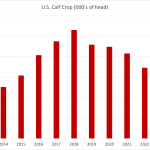By Glen Hallick, MarketsFarm
WINNIPEG, April 26 (MarketsFarm) – Intercontinental Exchange (ICE) canola futures were stronger on Tuesday, setting new contract highs in several positions before easing back.
The planting intentions report from Statistics Canada was one factor behind today’s increases. The federal agency projected this year’s canola acres to be almost 20.9 million, for a seven per cent drop from 2021.
Sharp upticks in Chicago soyoil, Malaysian palm oil and new crop European rapeseed spilled over into canola. Strong gains in global crude oil added more support to edible oils.
Read Also
Canadian Financial Close: Loonie weakens
By Glen Hallick Glacier Farm Media | MarketsFarm – The Canadian dollar pulled back on Monday, due to a lack…
However, they were tempered by losses in old crop rapeseed and Chicago soymeal. Soybeans were mixed, providing little direction to canola.
A trader said the markets will turn their attention to spring planting. There are hopes for a good start, especially across most of the Eastern Prairies. While replenished soil moisture levels will be beneficial to crops, wet conditions will delay seeding well into May.
The Canadian dollar was lower as the United States dollar continued its rise. At mid-afternoon, the loonie was at 78.11 U.S. cents, compared to Monday’s close of 78.38.
There were 27,767 contracts traded on Tuesday, which compares with Monday when 22,330 contracts changed hands. Spreading accounted for 14,242 contracts traded.
Settlement prices are in Canadian dollars per metric tonne.
Price Change
Canola May 1,200.90 up 16.20
Jul 1,194.80 up 27.70
Nov 1,107.80 up 26.00
SOYBEAN futures at the Chicago Board of Trade (CBOT) were mixed on Tuesday, with most of the old crop positions to the downside.
The United States Department of Agriculture reported two private sales of soybeans. One is for 132,000 tonnes of new crop soybeans to China and the other is for 133,000 tonnes of old and new crop soybeans to unknown destinations.
The USDA issued its crop progress report yesterday afternoon, which showed soybean planting at three per cent complete as of April 24. That’s two points behind the five-year average.
The Chicago Mercantile Exchange will increase the daily limits for the soy complex. Effective May 1, soybeans will go from 90 cents to US$1.15 per bushel, soyoil from four cents/pound to five and soymeal from US$25/short ton to US$30.
The USDA attaché in Argentina pegged the country’s 2022/23 soybean production at 51 million tonnes, compared to 41 million in 2021/22.
CORN futures were higher on Tuesday, as support from wheat edged out pressure from soybeans.
Corn planted in the U.S. reached seven per cent complete, well back of the five-year average of 15 per cent.
The CME said it will raise the daily limit on corn from 30 cents to 50 cents/bu., as of May 1.
The USDA attaché in Argentina estimated the country’s 2022/23 corn crop at 52 million tonnes, for an increase of nearly one per cent from the previous year.
WHEAT futures were stronger on Tuesday, due to the latest news from Ukraine.
Shipping lanes on the Danube River have closed due to sea mines drifting in from the Black Sea. Russia warned those countries supplying military aid to Ukraine that the conflict could turn nuclear.
The USDA said spring wheat planting was at 13 per cent in the ground, which placed it two points back of the five-year average. Winter wheat lost three points and is now at 27 per cent good to excellent, compared to 49 per cent a year ago.
Unlike the soy complex and corn, the CME will lower the daily limit for wheat, dropping it from 85 cents/bu to 70. on May 1.
The USDA attaché in Australia placed its 2022/23 wheat crop at 29 million tonnes, dropping 20.1 per cent from the previous year, due to reduced planted acres and small yields.
Total planted wheat acres in Canada for 2022 were forecast at 25.03 million, a 7.2 per cent increase from last year, according to Statistics Canada.








